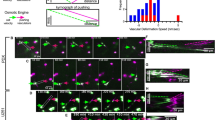Summary
Glioblastomas are highly invasive intracerebral tumors that are known to express the CD44 cell adhesion molecule. Human glioma cell adhesion and invasionin vitro may in part be mediated by the interaction of CD44 with extracellular matrix proteins. To suppress the growth and invasive effects of CD44 expression on primary brain tumors we have designed two hammerhead ribozymes as potential gene therapeutic agents. Both ribozymes designed to target exon 2 of CD44 exhibitedin vitro cleavage ofin vitro transcribed CD44s and CD44R1 RNAs. The anti-CD44 effect of these ribozymes results from directed RNA cleavage, requiring both a target sequence and an appropriate catalytic center. Further, following transient transfection of one of these ribozymes into the SNB-19 glioma cell line, significantin vivo cleavage activity against cellular CD44 transcripts was demonstrated by flow cytometrical analysis. These preliminary results suggest that CD44-directed hammerhead ribozymes may be useful as gene therapeutic agents.
Similar content being viewed by others
References
Lisziewicz J, Sun D, Metelev V, Zamecnik P, Gallo RC, Agrawal S: Long-term treatment of human immunodeficiency virus-infected cells with antisense oligonucleotide phosphorothioates. Proc Natl Acad Sci USA 90: 3860–3864, 1993
Joshi S, Brunschot AV, Asad S, Elst IVD, Read S, Bernstein A: Inhibition of human immunodeficiency virus type 1 multiplication by antisense and sense RNA expression. J Virology 65: 5524–5530, 1991
Skorski T, Nieborowska-Skorska M, Nicolaides NC, Szczylik C, Iversen P, Ioozzo R, Zon G, Calabretta B: Suppression of Philadelphia leukemia cell growth in mice by BCR-ABL antisense oligodeoxynucleotide. Proc Natl Acad Sci USA 91: 4504–4508, 1994
Symons RH: Small catalytic RNAs. Ann Rev Biochem 61: 641–671, 1992
Forster AC, Symons RH: Self-cleavage of plus and minus RNA's of a virusoid and structural model of activities. Cell 49: 211–220, 1987
Uhlenbeck OC: A small catalytic oligoribonucleotide. Nature 328: 596–600, 1987
Haseoff J, Gerlach WL: Simple RNA enzymes with new and highly specific endoribonuclease activities. Nature 334: 585–591, 1988
Kashani-Sabet M, Funato T, Florenes VA, Fodstad O, Scanlon KJ: Suppression of the neoplastic phenotypein vitro by an anti-ras ribozyme. Cancer Res 54: 900–902, 1994
Koizumi M, Kamiya H, Ohtsuka E: Ribozymes designed to inhibit transformation of NIH3T3 cells by the activated c-Ha-ras gene. Gene 117: 179–184, 1992
Scanlon KJ, Jiao L, Funato T, Wang W, Tone T, Rossi JJ, Kashani-Sabet M: Ribozyme-mediated cleavage of c-fos mRNA reduces gene expression of DNA synthesis enzymes and metallothionein. Proc Natl Acad Sci USA 88: 10591–10595, 1991
Sarver N, Cantin EM, Chang PS, Zaia JA, Ladne PA, Stephens A, Rossi JJ: Ribozymes as potential anti-HIV-1 therapeutic agents. Science 247: 1222–1225, 1990
Chen C-J, Banerjea AC, Harmison GG, Haglund K, Schubert M: Multitarget-ribozyme directed to cleave at up to nine highly conserved HIV-1env RNA regions inhibits HIV-1 replication-potential effectiveness against most presently sequenced HIV-1 isolates. Nucleic Acids Res 20: 4581–4589, 1992
Sun L-Q, Warrilow D, Wang L, Witherington C, Macpherson J: Ribozyme-mediated suppression of Moloney murine leukemia virus and human immonodeficiency virus type I replication in permissive cell lines. Proc Natl Acad Sci USA 91: 9715–9719, 1994
Eibl RH, Pietsch T, Moll J, Skroch-Angel P, Heider K-H, von Ammon K, Wiestler OD, Ponta H, Kleihues P, Herrlich P: Expression of variant CD44 epitopes in human astrocytic brain tumors. J Neuro-Oncol, 1995, (this issue)
Kaaijk P, Troost D, Morsink F, Keehnen RMJ, Leenstra S, Bosch DA, Pals ST: Expression of CD44 splice variants in human primary brain tumors. J Neuro-Oncol, 1995, (this issue)
Merzak A, Koocheckpour S, Pilkington G: CD44 mediates human cell adhesion and invasionin vitro. Cancer Res 54: 3988–3992, 1994
Dougherty G, Lansdorp PM, Cooper DL, Humphries RK: Molecular cloning of CD44-R1 and CD44-R2, two novel isoforms of the human CD44 lymphocyte ‘homing’ receptor expressed by hemopoietic cells. J Exp Med 174: 1–5, 1991
Author information
Authors and Affiliations
Rights and permissions
About this article
Cite this article
Ge, L., Resnick, N.M., Ernst, L.K. et al. Gene therapeutic approaches to primary and metastatic brain tumors: II. Ribozyme-mediated suppression of CD44 expression. J Neuro-Oncol 26, 251–257 (1995). https://doi.org/10.1007/BF01052628
Issue Date:
DOI: https://doi.org/10.1007/BF01052628




